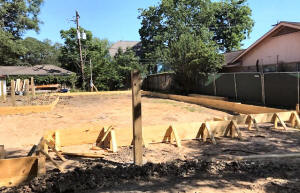|
Houston still rebuilding from 2017 floods
as new hurricane season arrives
 Send a link to a friend
Send a link to a friend
 [June 01, 2018]
By Liz Hampton and Ernest Scheyder [June 01, 2018]
By Liz Hampton and Ernest Scheyder
HOUSTON (Reuters) - In an empty lot where
Vincent Shields' Houston home once stood, he points out properties whose
owners were driven out after Hurricane Harvey inundated the region last
summer.
"On this street there's probably less than 30 percent occupancy," said
Shields, who tore down his house after the city ruled damage exceeded
half its value and it would have to be elevated before being repaired.
He and his wife moved into an apartment and began planning a new, higher
home at the same location.
It has been roughly nine months since Hurricane Harvey dumped trillions
of gallons of water on the U.S. Gulf Coast, killing 68 people and
causing an estimated $125 billion in property damage.
Shields and some 25,000 Texas households are still displaced, according
to the Federal Emergency Management Agency (FEMA). Nearly 80,000 homes
across Texas had 18 inches of floodwater or more during Harvey.
In Houston, data on people still out of their homes and awaiting repairs
are not available from the city. But U.S. Postal Service figures show
11,500 Houston homes became vacant between June 2017 and February 2018.

With the 2018 hurricane season beginning June 1, around 400 Houston
households are still living in hotel rooms funded by FEMA, according to
the agency's latest data. Many others remain in temporary housing
uncertain about their return home.
According to interviews with residents and neighborhood groups, many
owners of flooded homes are still enmeshed in the emotionally fraught
and expensive process of deciding whether to repair or elevate, or put
their property up for sale.
Shields said the months since Harvey have been tough and fears that
another major storm before the region fully recovers would be
devastating.
"I can survive this once - health, wealth, physically - but I can't do
it again," he said.
After three floods since 2014, local officials have added home-building
restrictions and rules on rebuilding in flood-prone areas, giving owners
of damaged homes costly new factors to consider.
Houston officials this year passed an ordinance requiring certain
dwellings to be raised to the 500-year floodplain level plus two feet.
Previously, only new homes had to start one foot above the 100-year
level.
JACKED UP HOMES
The requirements have forced some owners to jack up existing homes to
avoid the next flood.
Houston homes, typically built on slab foundations, can be mechanically
raised for an average cost of $100,000 to $300,000 in a months-long
project, said Wayne Fairley, a managing director at house elevating
company Planet Three Elevation.
Fairley has tripled his workforce since Harvey to meet growing demand,
he said. Subcontractors who once handled plumbing and electrical
projects for the company now work for him full time.
"There were a lot of contracts signed post-Harvey," said Fairley. About
5 to 10 percent of his clients are elevating their homes preemptively,
and a large portion of his work is in Houston's Meyerland neighborhood,
which was hit by three major floods in recent years.
Nancy Wilson and her husband decided to tear down and build anew rather
than spend the estimated $250,000 to raise and then remodel their 1950s
home. The new house will be six feet higher than the old one, which got
two feet of water during Harvey.
"I'm almost positive it will flood again," said Wilson, a therapist, who
hopes to move back by early next year. In the interim, the family is
living a few miles away in a rental property.
"Honestly, I wish we were rebuilding higher," said Wilson. "Six feet
might not be high enough."
[to top of second column]
|

A new home being constructed six feet above the ground to replace
the one destroyed by Hurricane Harvey in 2017 is shown in the
Meyerland neighborhood of Houston, Texas, May 16, 2018. Photo taken
May 16, 2018. REUTERS/Ernest Scheyder

STILL IN LIMBO
Gwen McGlory moved to west Houston's Cinco Ranch neighborhood a
decade ago for its good schools and gated subdivisions. Her house
flooded after the city released water from a nearby reservoir to
relieve stress on a dam, forcing her to find temporary housing.
Now, most mornings she drops her 14-year-old daughter off long
before school has opened and picks her up hours after it has closed
because the school system lacks funding to provide transportation
from her current location.
"It's concerning when I'm dropping her off at a dark school,"
McGlory said, who is worried the transportation issues will continue
into the next school year.
McGlory says she received $33,000 from FEMA after Harvey. Of that,
$17,000 was earmarked for home repairs, despite bids from
contractors pegging her damages closer to $70,000. The Red Cross
worker recently was accepted to a rebuild and repair program run by
a community group.
"I'm so overwhelmed. I am working and a single parent with two kids.
I've never rebuilt a house before," said McGlory, who had no flood
insurance because her house was not in a floodplain.
While McGlory considered selling her property, an investor shortly
after the storm offered $100,000 less than what she had paid for it.
Historically, home values in hard-hit areas can fall between 7 and
20 percent immediately after a flood, said Ed Wolff, president of
real estate firm Beth Wolff Realtors and governmental affairs chair
for the Houston Association of Realtors.
"You see a rebound after 18 to 24 months. As we get further away
from the event the memories fade," said Wolff, who decided to
elevate his Meyerland home by almost six feet after Harvey and
returned in early May.
The devastation of Harvey has pushed local officials and agencies to
expand efforts to mitigate the impact of floods. Last year, county
officials authorized $20 million to buy out homes that have
routinely flooded.
The Harris County Flood Control District, which established its own
buyout program in 1985, recently submitted a grant for state funding
to buy homes damaged by Harvey. It has also focused on repairs to
drainage infrastructure and removing debris from Harvey that could
block waterways before the next hurricane.

Officials across the nation are becoming more aware of the dangers
of urban flooding, which is aggravated by unbridled development,
said Sam Brody, a professor in the Department of Marine Sciences and
flooding expert at Texas A&M University in Galveston.
"Harvey exposed these underlying problems that cities such as
Houston, Miami and Chicago face," he said.
Texas is considering sweeping changes, including urging residents to
buy flood insurance and raising the level of new homes, he said.
But the measures will take time to implement, Brody said. "There is
a good likelihood we are going to get a major storm event before we
are even partially recovered from this one."
(Reporting by Liz Hampton and Ernest Scheyder in Houston and Jon
Herskovitz in Austin; Editing by Gary McWilliams and Richard Chang)
[© 2018 Thomson Reuters. All rights
reserved.]
Copyright 2018 Reuters. All rights reserved. This material may not be published,
broadcast, rewritten or redistributed.
Thompson Reuters is solely responsible for this content. |